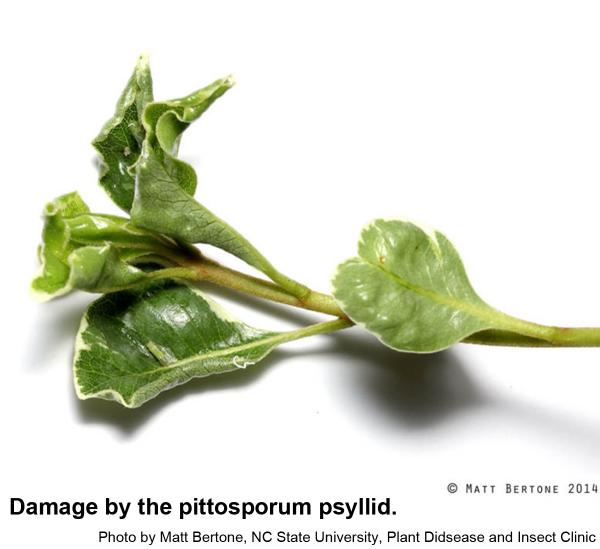Description and Biology
The pittosporum psyllid, Cacopsylla tobirae, is a very small, pale green, leafhopper-like insect with transparent wings and white eyes that have a dark "pupil." The antennae are about half as long as the insect, and they are grayish green at the base and almost black at the tips. Nymphs are flat insects with a fringe of filaments around the perimeter. They feed through the surface of leaves and inject saliva as they feed. In general, psyllids in this genus overwinter as nymphs in the buds. In spring, the nymphs feed in new growth causing it to become puckered and distorted. The damaged leaves may form a shelter in which the nymphs feed and secrete their strands of fluffy white wax. Adults are formed in May and June. Eggs are laid in early summer and hatch in late summer but the new psyllid nymphs stay buried in the buds until the following spring.
Host Plants
The pittosporum psyllid attacks mock orange and pittosporum. Signs of damage include swollen twigs and shoot dieback, pitted leaves, and fluffy, white strands secreted by nymphs as they feed.
Residential Recommendations
As with many invasive species, pittosporum psyllids left their predators and parasites behind so that chemical control may be the only alternative management strategy other than replacing pittosporums with some other shrub except mock orange. Systemic insecticides are easy to apply and they provide a relatively long period of pest suppression. According the the University of California at Riverside web site, imidacloprids and other neonicotinoids “have low, moderate, or severe adverse impact on natural enemies and pollinators, varying with the product, situation, and the species and life stage of invertebrate. Neonicotinoid insecticides can translocate to flowers and poison natural enemies and pollinators that feed on nectar and pollen. Delay systemic insecticide application until after plants have completed their seasonal flowering, unless the product label directs otherwise. Where other plants grow near treated plants, those other plants may also take up some of the soil-applied insecticide or become contaminated with insecticide spray drift. Delay soil application or foliar spraying of systemics when possible until the nearby plants are also done flowering.”
Other Resources
- Cacopsylla tobirae (Miyatake) (Hemiptera: Psyllidae), a Pest New to North and South Carolina on Japanese Pittosporum (Pittosporaceae: Pittosporum tobira). Bertone, M. A. 2016. Proc. Entomol. Soc. Wash. 118(4), 2016, pp. 641–644.
- Pittosporum psyllid in NC. Frank, S. D. 2014. ECOIPM, Insect Ecology and Integrated Pest Management.
- Psyllids. Kabashima J. N. et al. 2014 (revised). University of California Agriclutre & Natural Resources.
- Extension Plant Pathology Publications and Factsheets
- Horticultural Science Publications
- North Carolina Agricultural Chemicals Manual
For assistance with a specific problem, contact your local Cooperative Extension Center.
This Factsheet has not been peer reviewed.
Publication date: Jan. 9, 2020
Revised: Jan. 9, 2020
Recommendations for the use of agricultural chemicals are included in this publication as a convenience to the reader. The use of brand names and any mention or listing of commercial products or services in this publication does not imply endorsement by NC State University or N.C. A&T State University nor discrimination against similar products or services not mentioned. Individuals who use agricultural chemicals are responsible for ensuring that the intended use complies with current regulations and conforms to the product label. Be sure to obtain current information about usage regulations and examine a current product label before applying any chemical. For assistance, contact your local N.C. Cooperative Extension county center.
N.C. Cooperative Extension prohibits discrimination and harassment regardless of age, color, disability, family and marital status, gender identity, national origin, political beliefs, race, religion, sex (including pregnancy), sexual orientation and veteran status.


